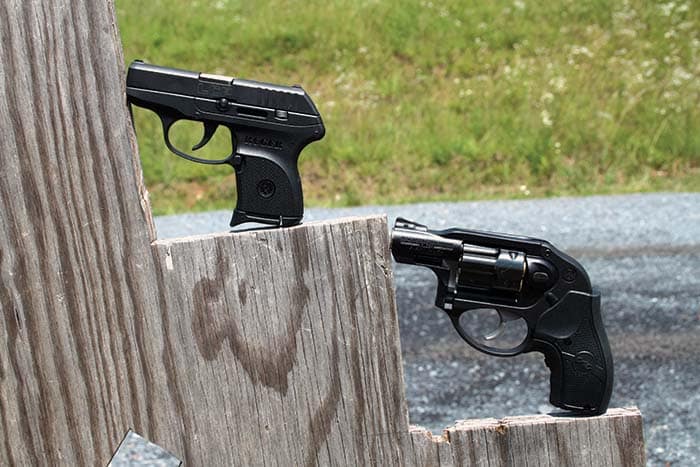By Todd Burgreen, Photos by Ethan Burgreen
The proliferation of concealed carry has led to a spike in compact handgun introductions over the last several years. Yes, many articles rightfully tout the abilities of full size handguns typified by GLOCKs, 1911s, and other types. Interestingly, the so called facts of life often intercede making carry of full size handguns impractical in certain settings either by clothing restrictions or mindset of practicing concealed carry. Do not think that your full size handgun of choice will always be convenient to discretely carry no matter how much you can alter your daily clothing or styles. The plethora of .38 Special snub-nosed revolvers and .380ACP semi-automatics being sold are proof positive that for many “convenience of carry” outweighs “willingness to carry” full sized handguns.
Handguns are accepted as a compromise in terms of lethality traded for portability compared to rifles or shotguns. A manufacturer that is developing into a noteworthy force in the US for all firearm categories, albeit sporting, competition, or personal defense, is Sturm, Ruger & Co. Currently, Ruger offers 400 model variations across 70 different products encapsulated within 25 distinct product lines. The Ruger LCP (Lightweight Compact Pistol) and LCR (Lightweight Compact Revolver) were both introduced several years ago in response to market impulses involving the increase in popularity of concealed carry type weapons. Ruger’s introduction of the LCP in 2008 and LCR in 2009 sought to combine proven personal defense cartridges to the smallest, lightest, practical packages.
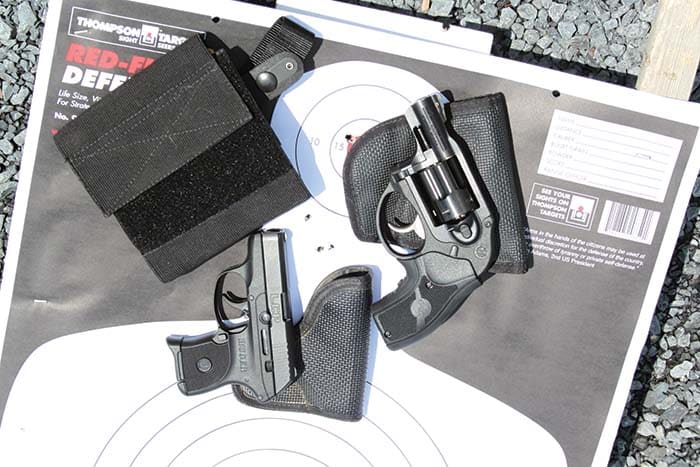
The LCP is a semi-automatic chambered in .380ACP. Capacity is 6+1 fitting into a 9.65 ounce 5-inch long by 3.6-inch high by 0.82-inch wide package. An optional seven round magazine that extends below the magwell is available. The fixed sights are purposely minimal to reduce snagging for a handgun destined mainly for pocket or other types of concealed carry. The pistol has a glass filled nylon frame and a steel slide. The trigger is double action only (DOA) without re-strike capability. The Ruger LCP operates via Browning’s swinging link design as found in the 1911 and Hi-Power. Most handguns of such small dimensions are blowback operated. Recoil is minimized and reliability is enhanced by using the Browning method. Dual recoil springs supported by the non-captive metal guide rod are located beneath the barrel. A large spring loaded external extractor is used along with an external slide stop. A user can visibly inspect the LCP to see if a round is chambered via a view gap provided in the slide/chamber area. The LCP’s 2.75-inch barrel has an integral feed ramp and is bull nosed at its end to engage with the slide similar to what is found on bushingless 1911 models. There is no manual safety on the Ruger LCP with only a slide stop lever found on its frame. The trigger pull is typical of DOA semi-automatics measuring 6 pounds. The LCP is hammer fired. The LCP’s hammer does not protrude from the rear of the slide. Importantly, the LCP does not have a magazine disconnect allowing for it to fire without a magazine in place; an advantage for any weapon destined for personal defense encounters that predominantly occur in close quarters.
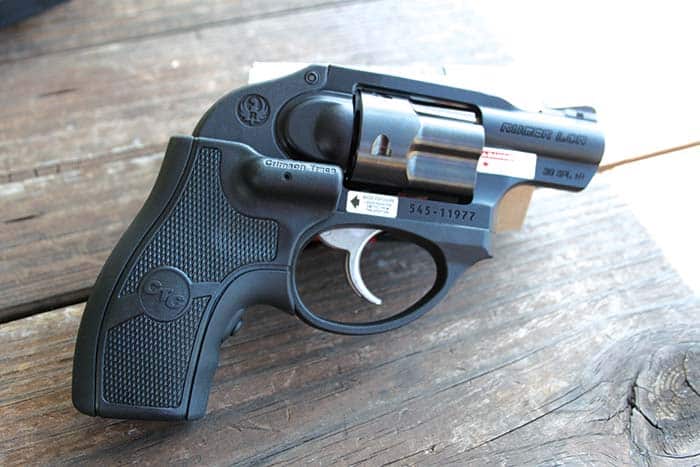
There are multiple LCP models available from Ruger that incorporate various sight systems including a Crimson Trace laser. Light weight is a feature much appreciated in any weapon destined for concealed carry whether in a pocket, belt, or other methods. Light weight often translates into not being left behind. The rear of the slide is serrated for positive tactile feel when operating the slide. The polymer frame interfaces with the steel slide positively along its length for smooth functioning. The trigger guard is slightly oversized compared to similar competitor models for easy access to the trigger when hurried.
Most will immediately think of the “snubby” when .38 Special personal defense revolver is mentioned. For sure, the “snubby” is holding its own in terms of use in the self-defense realm. The Ruger LCR can be had in several variants: .357Mag, 38Spl only, 22LR, 22WMR, exposed hammer, concealed hammer, Crimson Trace grips from factory etc. This article will feature the .38 Special +P LCR with Crimson Trace grips. What sets apart the Ruger LCR series from other snub nosed revolvers is the patent pending polymer fire control housing and friction reducing trigger cam that results in a smooth non-stacking double action trigger pull. Ruger must have spent countless hours designing and tweaking the trigger and associated springs. The LCR trigger is smooth and lacks any stacking when the trigger is pulled rearward. The LCR’s monolithic frame is made from aerospace grade 7000 series aluminum and synthetic glass-filled polymer finished in matte black. The LCR’s fluted cylinder is made from blackened 400 series stainless steel. The stainless steel cylinder is designed to handle full-power .38 Special +P loads. The LCR’s front latching system uses titanium components, optimized spring tension and enhanced lockup geometry to ensure the cylinder stays locked in place during firing. The LCR tested weighs 13 ounces and has a five-shot cylinder. Length of the LCR is 6.5-inches and height is 4.5-inches. The 17-4 PH stainless steel 1.8-inch barrel has 1:16 twist. The LCR frame’s grip peg allows for a variety of grips to be installed with the standard Ruger offering being a Hogue Tamer grip with a Sorbothane insert. Crimson Trace laser grips were installed on LCR for this review. The Ruger LCR represents a refinement of the classic .38 Special snub nose revolver by involving new materials and trigger feel.
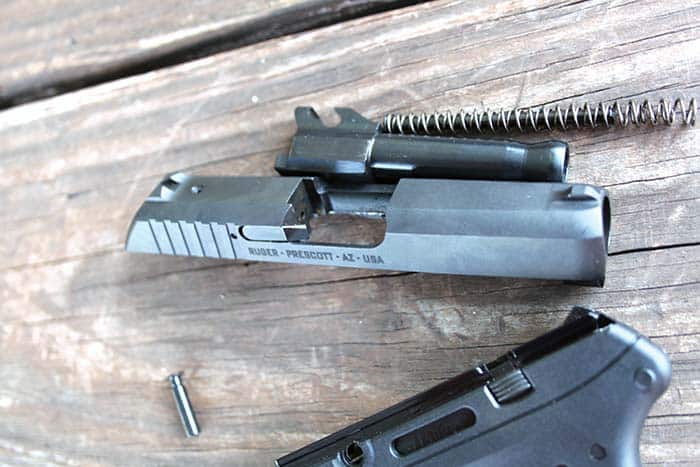
The frame with Synergistic Hard Coat and stainless steel cylinder with Ionbond Diamondblack finish makes the LCR highly corrosion resistant. This is an important consideration for a concealed weapon that will be carried against your body for extended amounts of time. The LCR model tested has a concealed hammer, which limits any snagging on clothing when drawn in a heated fashion or operating from within a pocket. This was a real benefit when rounds were fired in a rapid fashion at close range—the likely mode when called upon in a close range defensive encounter.
The integral U-notch rear sight fits into the LCR’s simple effectiveness and expected range of engagements. The Ruger LCR model tested herein arrived with Crimson Trace Laser grip. Lasers have gained steady acceptance and popularity over the years. The visual red dot aids in accurate one handed firing and helps aim the Ruger LCR no matter what unorthodox firing position one may find themselves in. Another consideration for a weapon expecting use at close quarters is that the CTC Laser Grip allows for aimed fire while still keeping the weapon close to the body. This reduces the chance of a weapon take away if extended out for sighted fire. The CTC laser mounted in the grip area does not change any frame dimensions negating the need for custom holsters.
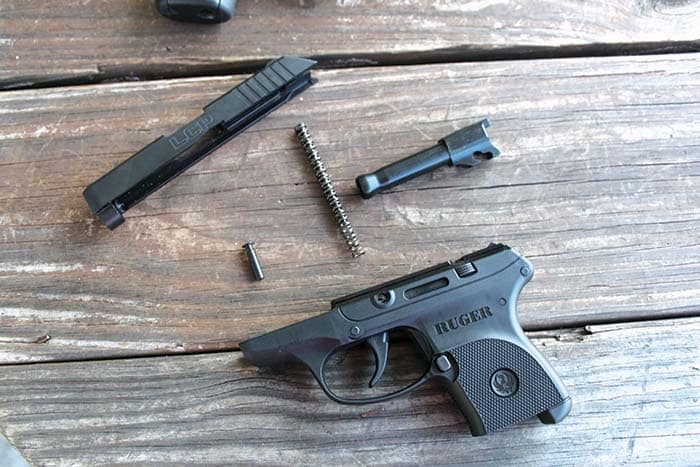
The LCR CTC Laser grip was first sighted in by indexing the laser to the same point of aim as the revolver’s fixed sights down a long hallway. This proved right on once tested at the range. The laser emitting diode is situated high on the right grip panel with the activation button located on the grip. The CTC Laser Grip is not solely defined by the laser installed in it. The CTC Laser Grip is ergonomically designed to offer the shooter comfort and control when shooting the LCR. The backstrap is wider than the stock grips and come up higher on the revolvers frame allowing for recoil to be distributed across a wider area. This translates into less recoil imparted to the shooter. The Crimson Trace Laser Grips act as a force multiplier making the Ruger LCR even better in a defensive encounter.
A primary method of carrying both of the Rugers was in a DeSantis Nemesis pocket holster. It was noticed that the Ruger LCP benefits from Ruger giving it the “melt” treatment rounding the slides edges and other points on the pistol to minimize any chance of it snagging on clothing when deployed. This shows design following intent of the LCP as a concealed carry weapon.
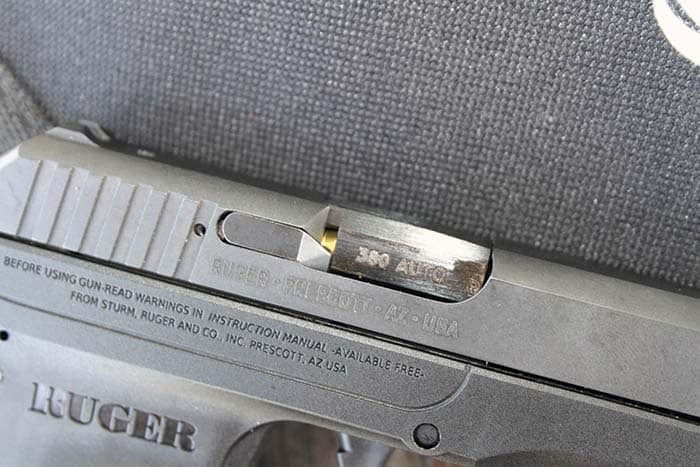
Personal defense ammunition for the .380ACP and .38 Special is enjoying a renaissance. For example, .380ACP ammunition has benefitted greatly from recent advantages in bullet and propellant advances. The Hornady Critical Defense 90 grain FTX .380ACP is a great example of this. Hornady utilizes propellants that minimize muzzle flash while maximizing velocity. The FTX bullet is the result of much research into what features a bullet designed for personal defense should consist of. Everything from the bullet profile to ensure reliable feeding to the polymer nose that guarantees proper expansion no matter the medium the FTX passes thru when striking its intended target. Overall, 380ACP ammunition availability seems improved of late with ammunition being more readily found on dealer’s shelves. Loads tested with Ruger LCP consisted of Hornady 90 grain Critical Defense, American Eagle 90 grain FMJ, and Winchester 95 grain PDX.
Hornady 125 grain, 140 grain, and 158 grain HP/XTP loads were used in the Ruger LCR. The Hornady loads produced minimal muzzle flash when fired. This is often overlooked in testing ammunition intended for defensive purposes. The Hornady 158 grain HP/XTP was settled on for daily carry. Unlike the .357 Magnum, where the 125 grain loading’s high velocity makes it a favored choice, the 38 Special, especially with a 2-inch or shorter barrel, needs a heavier bullet to be most effective. The Ruger LCR instilled confidence with its accuracy with both paper and steel targets engaged out to 10 yards.
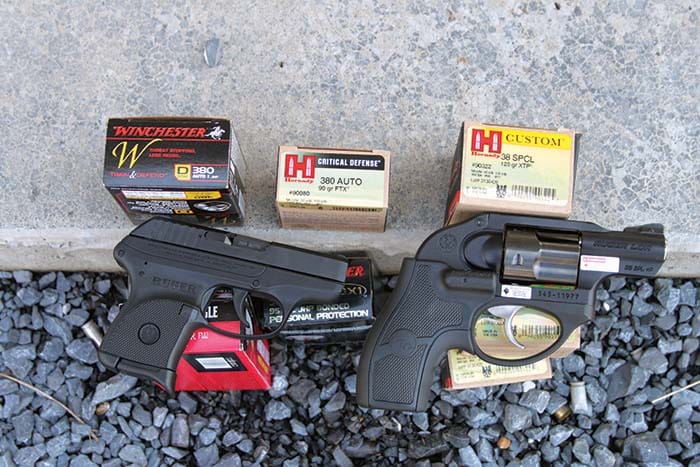
Range evaluation for both the Ruger LCP and LCR consisted of normal protocol establishing reliability first, then getting into combat accuracy and handling. Several magazines/cylinders worth of ammunition was spent engaging plate racks and man-sized steel targets. No malfunctions were encountered with either handgun. The Ruger LCP and LCR’s ergonomic design allowed for minimal felt recoil and ease of getting multiple shots off quickly even with the lightweight of each. Both fit the hand better than many competitor models. After reliability was verified, time was spent manipulated the LCP and LCR from DeSantis pocket holsters. More of a point shooting or flash sight picture was utilized along with one handed firing grip. This to be a more realistic way of analyzing what the Ruger compacts bring to the table for user’s considering using them in the role it designed for—concealed carry personal defense.
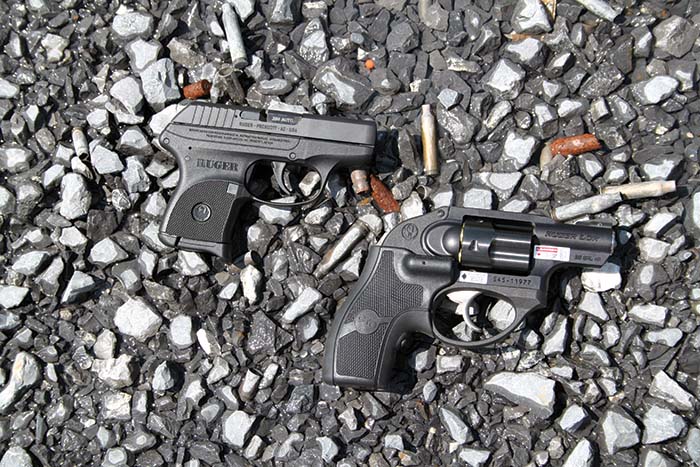
The Ruger LCP’s trigger is familiar in feel to other triggers experienced, especially for long time striker fired semi users. The minimal sights found on the LCP are adequate for engagements that dominate the personal defense arena and were not a hindrance in engaging targets up to 7 yards away accurately. Similar comments can be directed to the Ruger LCR’s iron sights. However, the Crimson Trace Laser grips add another dimension to the LCR’s use. There was no problem seeing the laser on the target even when testing outside in bright sunlight. Most defensive encounters (80%) occur in low light conditions where the laser is crisp and bright and actually may work as a deterrent when seen by an attacker. After a couple of boxes of shells, there was nothing extraordinary about running a plate rack with the Crimson Trace Laser Grip equipped Ruger LCR fired from the hip at 7 yards using only the laser. Training with the Crimson Trace Laser Grip as serious as one would with open sights is urged. Many comment that fire may seem slower at first when using the Crimson Trace Laser Grips. This stems from looking at both the fixed sights and laser before firing the shot. The laser’s advantage rests in the natural tendency to focus on the imminent threat versus at the front sight interposed between the threat and the shooter. The laser will be seen on the target where the eye is naturally drawn. The key to greater success is to look at the target, pick up the flash of the laser, and squeeze off the round without referencing the fixed sights. Shooters have to gain confidence that the bullet will indeed strike where the laser is aimed. This is achieved by practice. Training with iron sights puts so much emphasis on sight picture that it takes time getting used to finding the laser on the intended target without referencing the front sight. If you sight the Crimson Trace Laser Grip in properly, the bullet will hit where the laser is projected.
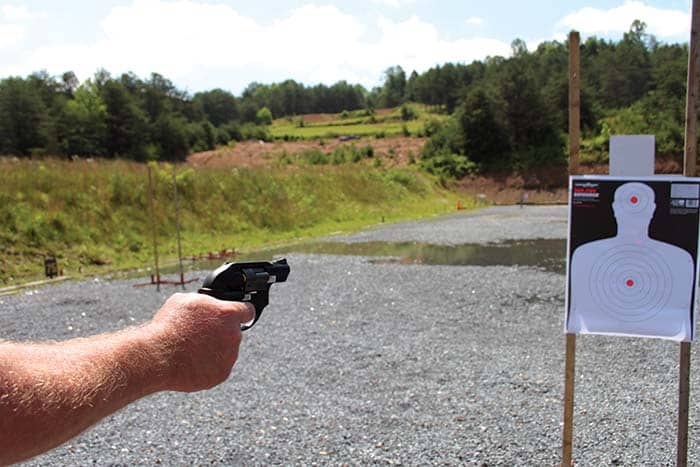
The Ruger LCP and LCR will find their way into several roles as a personal defense handgun. Each will definitely find a niche as a back-up gun. Many will find the handy nature of the both the LCP and LCR make them indispensable and not being able to leave the house without either even when a larger weapon is carried. Others will find the LCP or LCR becoming their primary carry weapon by default, especially in summer months or under social conditions were discovery of a concealed carry weapon is unthinkable. The .380ACP and .38 Special cartridges have benefitted just as much as the 9MM in terms of bullet development increasing terminal capabilities. The Ruger LCP and LCR share the same strong suits in terms of being lightweight and minimal dimensions ensuring always being present. One just has to choose if you want a semi automatic or a revolver.
SITES OF INTEREST
Sturm, Ruger & Co., Inc
www.ruger.com
DeSantis Holster and Leather Goods
www.desantisholster.com
HornadyMfg.Inc
www.hornady.com
Winchester Ammunition
www.winchester.com
| This article first appeared in Small Arms Review V20N1 (January 2016) |



